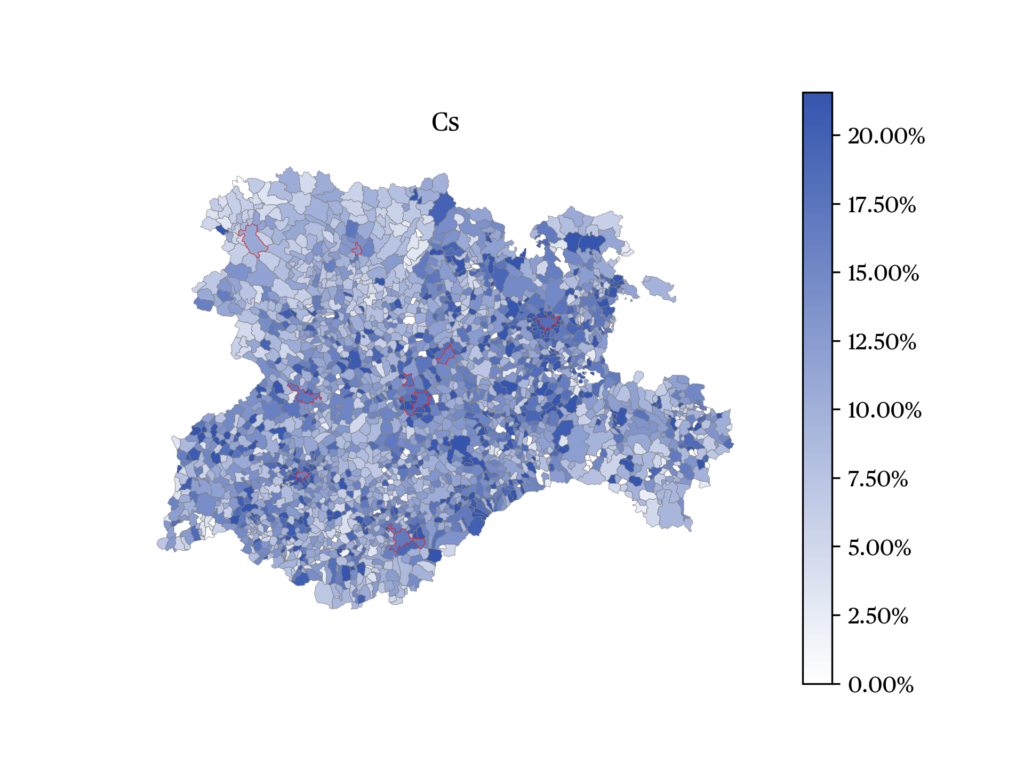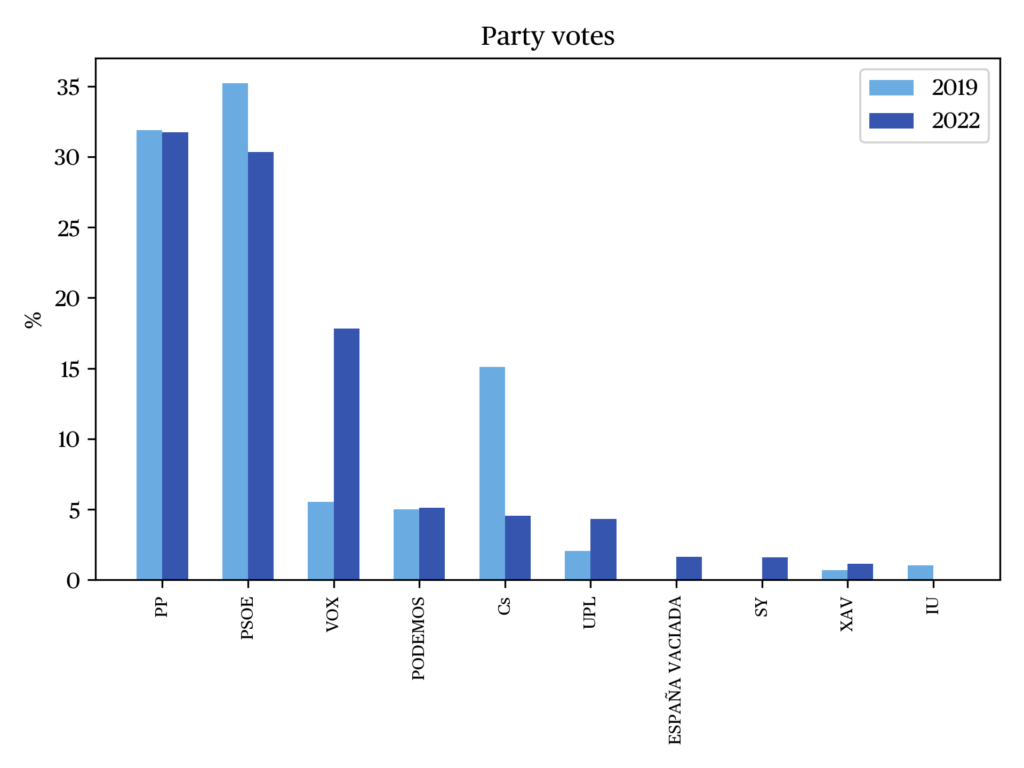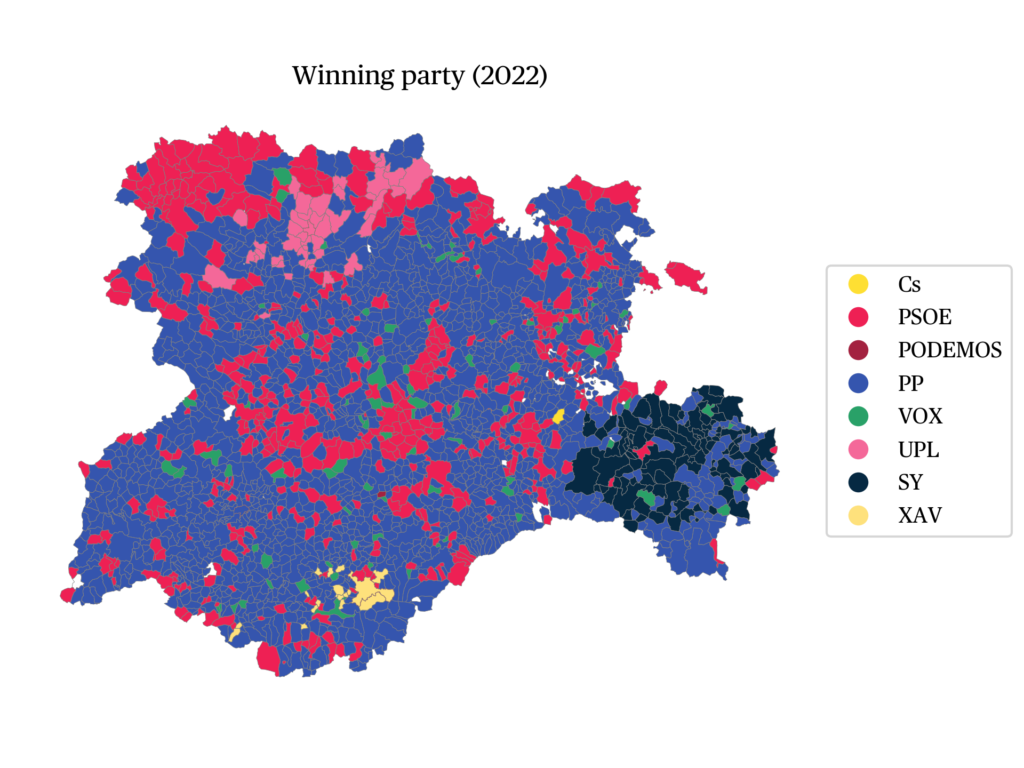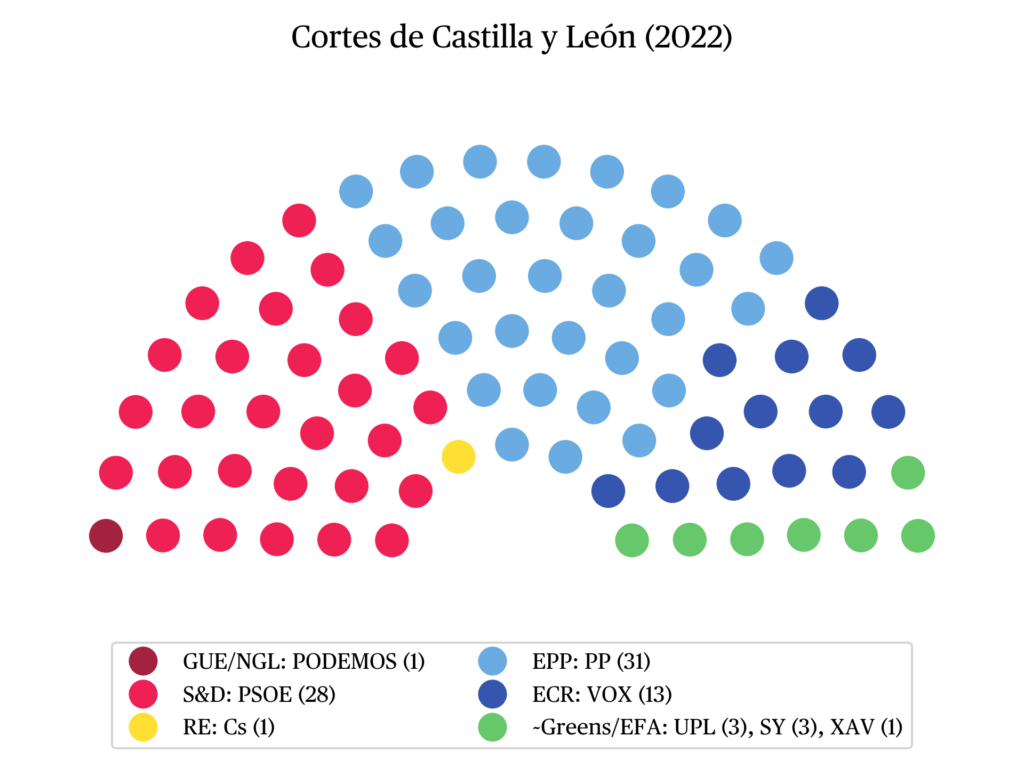Regional election in Castilla y León, 13 February 2022
Luis Mena Martínez
Professor at Salamanca University’s History and Geography departmentIssue
Issue #3Auteurs
Luis Mena Martínez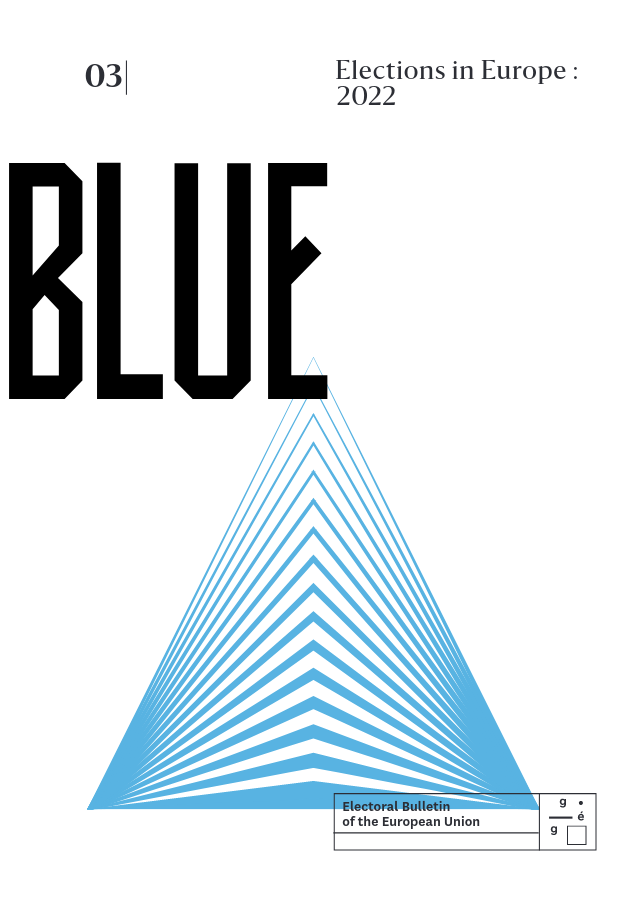
Issue 3, March 2023
Elections in Europe: 2022
In 2022, for the first time, the regional election in Castilla y León was organized independently of other regional or national ballots; the previous elections had been held on the same day as the municipal elections and the regional elections in most of Spain’s Autonomous Communities. This change was accompanied by a slight loss in turnout with respect to 2019 (from 65.8% to 63.4%). This is the lowest turnout figure in a regional election, although very close to the same figure in the 2011 election.
To understand what has happened in these elections, we will analyze the evolution of the results in regional elections since 2011 (2011, 2015, 2019 and 2022).
In Castilla y León, the Partido Popular (PP) has obtained parliamentary majorities from 1991 to 2019, and has been governing the region since 1987, for 35 uninterrupted years. The Spanish Socialist Workers’ Party (PSOE) won the first election (1983) as well as the 2019 election, although, in the latter case, he failed to form a coalition government. When it did not achieve a majority, the Popular Party has gathered the parliamentary support needed to govern from other right-wing groups (the Democratic and Social Center in the 1987-1991 legislature, Ciudadanos in 2019-2022, and Vox since 2022). Despite a lack of alternation in power, there have been relevant changes in the party system since 2011 (the last elections with ‘traditional’ results). In the following, we analyze these changes along three axes:
- The ideological left-right axis
- The axis between traditional and new parties
- The axis between national and provincial parties (to this day, no Community-oriented party has ever obtained parliamentary representation in Castilla y León).
Axis 1: Right v. left
In terms of both popular vote and elected representatives, the Community of Castilla y León has been historically right-leaning. The parties traditionally identified as left-wing are the PSOE, Podemos and the United Left, while the parties traditionally identified as right-wing are the PP, Ciudadanos, Vox and Union Progress and Democracy. 1 Although the distribution of votes and seats within each bloc varies over time, the cumulated vote shares of left-wing and right-wing parties have remained relatively stable, with a percentage of votes and seats superior to 50% for the right, while the left was able to surpass the 40% mark in only a few occasions. Parties that cannot be located on the left-right axis (typically, provincial parties) have caused a loss of votes for the left bloc in the last elections.
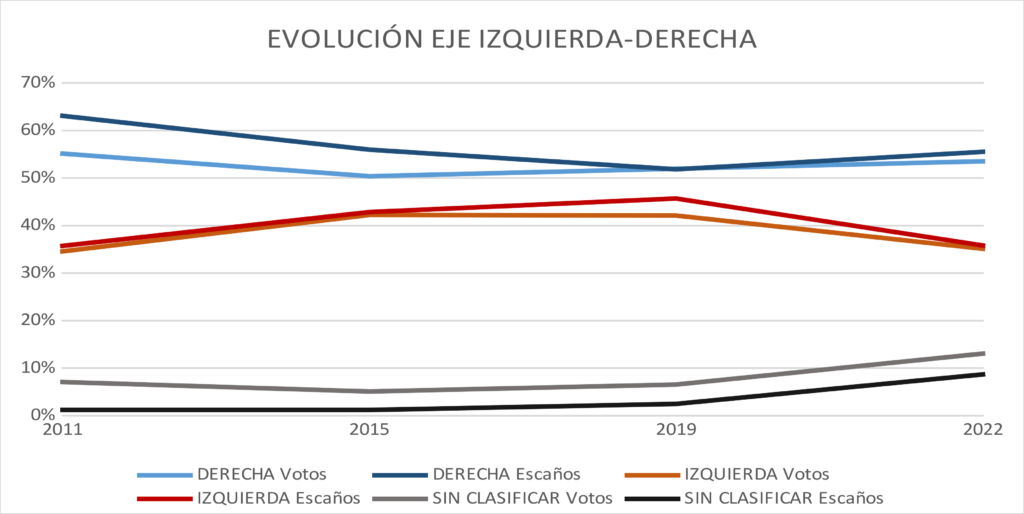
Axis 2: Traditional v. new parties
Until 2011, the two largest traditional parties (PP and PSOE) won most of the seats in the parliament of the Autonomous Community. Together, the two parties gathered about 80% of the popular vote, and their seat shares were boosted by the electoral system in place. The 2015 election put an end to this bipartite hegemony, and the shares of new parties has stabilized since then, reaching over 20% of the seats and 33% of the vote. The current regional parliament has the highest number of parties represented in the history of the Community.
Since 2011, a change in electoral behavior is observed, which has been interpreted as an expression of disenchantment with traditional parties. This has led to the emergence of new parties with parliamentary representation, despite the electoral system favoring large parties. This way, the diversification that has taken place in the national party system with the emergence of new parties with parliamentary representation — Podemos, Ciudadanos, and Vox —, has been translated on the regional political scene. While the overall vote share of new parties has been relatively stable, the shares of individual parties have varied significantly since 2015.
Podemos played a leading role in the 2015 election, when it obtained 12% of votes and seats. In 2019, however, it only gathered 5% of the vote and 2.5% of the seats, while the PSOE’s vote share grew from 26% to 35%, and its seat share from 30% to 43% as the party successfully concentrated left-wing votes. In the last election, despite a coalition with the United Left, Podemos stagnated at 5% of the vote and only obtained one seat. Its vote was urban, and, in 2015, was concentrated in districts of the main metropolitan areas, a few less populated provincial capitals (Soria, Zamora) and other smaller cities (Ponferrada, Villablino, Aranda de Duero, Miranda de Ebro), with little rural presence.
Ciudadanos also emerged in the 2015 election with 6% of the seats and 10% of the votes. They achieved their best results in the 2019 election, with 15% of both votes and seats. However, their score plummeted in the 2022 election, falling to 4.5% of votes and only one seat. In 2019, Ciudadanos voters were concentrated in the peripheral areas of metropolitan areas, as well as in some districts of the provincial capitals.
Vox is the youngest of these new parties. In 2015, it obtained 1% of the votes, and in 2019, its vote share grew to 5.5%, earning it its first seat in parliament. In 2022, Vox gathered 17.5% of the votes and obtained 16% of the seats. Vox voters are much more evenly distributed over the territory of the Autonomous Community, with a stronger presence in rural areas.
Ciudadanos and Vox are both associated with Spanish nationalism, which has been reinforced, at the national level, by the dynamics of other regional nationalisms. In these respects, the national political dynamics are better known and more relevant than the regional political reality. Changes in regional voting patterns follow those occurring at the national level. The best example of such an evolution is the success of Vox in 2022: their candidate was little known at the regional level, and their campaign centered around the figure of their national leader, Santiago Abascal. Their success thus rather resulted from their national popularity than from their regional programs and candidates.
Despite common features, there have been no significant transfers of votes between Ciudadanos and Vox. This can be seen by comparing the distribution of the Ciudadanos vote in 2019 and the Vox vote in 2022.
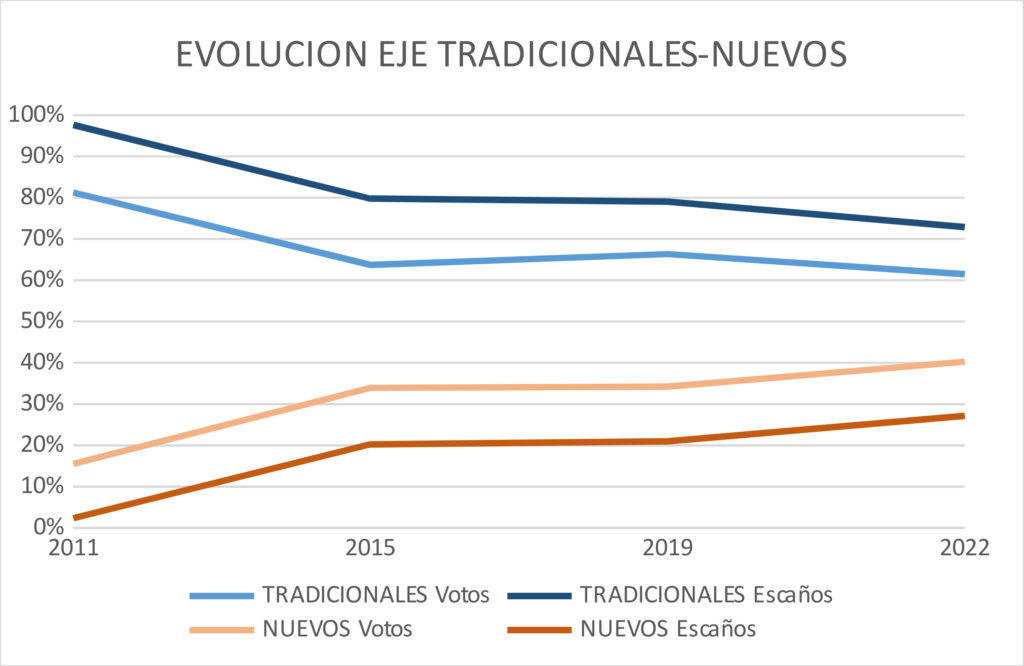
Axis 3: National v. provincial parties
In the 2022, the most significant novelty was the strong increase in the parliamentary presence of provincial parties, which grew from one to seven seats (9% of the parliament).
It must be noted that these parties develop a political discourse focusing on individual provinces, rather than the entire Autonomous Community. Just as before, Community-centric parties show very little mobilization capacity in Castilla y León. On the contrary, provincial parties originating from three of nine of the provinces are now represented in the regional parliament.
Castilla y León is a very large region with a weak sense of common belonging. Every province has its own dynamics and interests, leading to different voting patterns, including in the results of the two traditional parties.
At the national level, new parties with territorial, but non-nationalist roots have emerged (their archetype is Teruel Existe, a provincial party which has achieved representation in the national parliament). In Castilla y León, similar political discourses have been articulated around the sensasion of abadonment felt in some of the less urbanized and depopulated areas of what has been called “empty Spain.”
In only three years, the provincial parties have increased their presence from 5% of the votes and 2.5% of the seats to 9% of both votes and seats. It remains to be seen if this share will stabilized, as has occurred with the new parties since 2015.
While provincial parties were running in all constituencies, only three of them eventually obtained seats in parliament. The Union of the Leonese People (UPL) was the only provincial party traditionally represented in the parliament of the Community (even though the party focuses its discourses on the Leonese region – which includes León, Zamora, and Salamanca –, in practice it only obtained seats in the province of León), and has been strengthened by the reinforcement of the territorial axis. Soria Ya (SYA) is a social movement that, together with Teruel Existe, has been pioneering “empty Spain” revendications for years. It has been able to increase its vote share in its home province, mostly at the expense of the PSOE. Por Ávila (XAV) is a provincial party that was split off from the Popular Party; it is centered around the figure of its leader and is not part of the “empty Spain” movement, and has been able to preserve the seats it had secured in the 2019 election.
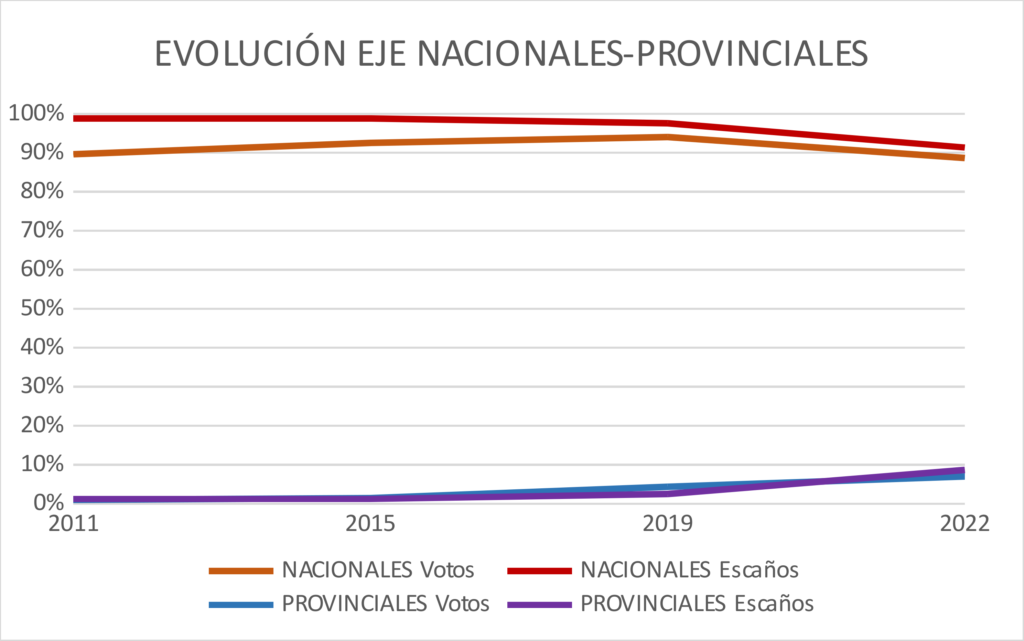
Principal Component Analysis of municipality-level results
We have performed a Principal Component Analysis of the vote at municipality level to identify groups of municipalities whose voting patterns deviate from the Community average, and analyze their specific behavior.
In the following, we discuss the first six components of the vote in both 2019 and 2022. Each of the components is different in the two elections, which is reflected in the tables below. We will analyze them in light of the three previously introduced axes. This will allow for a more in-depth analysis of the evolution of the electoral behavior in Castilla y León.
The principal component that explains the largest share of municipality-level variance corresponds to our first axis, i.e., to the right-left cleavage, and mostly involves the two traditional parties (PP and PSOE). Clearly, a larger share of the variance is explained by this component in 2019 than in 2022. The territorial distribution is also different, as can be seen in the following figures.
Regarding the second axis, we observe that various principal components give a negative weight of the two traditional parties. While this is the case of only two components (2 and 3) in 2019, all other components (2-6) are concerned in 2022.
In 2019, three components (2, 3, and 5) give a stronger weight to new national parties: component 2 captures Ciudadanos strongholds (with higher than average vote shares for Podemos and Vox), and explains 17% of the variance; component 3 corresponds to municipalities with lower Ciudadanos, PP, and PSOE vote and higher provincial (UPL, XAV), Podemos, and Vox vote, and explains 7% of the variance. Finally, component 4 corresponds to areas of strong Podemos (and Por Ávila) vote, with less support for other new parties and the PSOE; it explains 4% of the variance.
In 2022, we focus on the components which involve the new national parties (3 and 6). In component 3, we see areas of strong VOX vote, with some degree of UPL, XAV, and Ciudadanos support, which explains 17% of the variance. Component 6, which only explains 4% of the variance, captures municipalities with higher than average support for Podemos, Ciudadanos, and other “empty Spain” parties without parliamentary representation.
The territorial distribution of the component with the largest vote share for the most successful new party (Ciudadanos in 2019: component 2, and Vox in 2022: component 3) is also different. In 2022, Vox enjoys a much broader territorial basis, which includes many rural municipalities.
In summary, the second axis (new v. old parties) explains around one-third of the variance, and is divided into two components: a main component centered around the most successful party (Ciudadanos in 2019 and Vox in 2022), and a secondary one with less votes for the most successful party and more votes for other new parties.
The third axis, which contrasts national and provincial parties, displays the strongest variation between 2019 and 2022. In 2019, two components (4 and 6) display a stronger vote for provincial parties (UPL and XAV), explaining 7% of the variance. In 2022, a new component reflecting the Soria Ya vote (component 2, which explains 22% of the variance) emerges, while the components capturing the UPL (component 4) and Por Ávila (component 4) votes remain. In total, these three components explain 26% of the variance.
Obviously, their territorial distribution reflects the provinces they intend to represent (Ávila, León, and Soria). However, it is interesting to note, especially regarding Soria, that local parties have contributed to slow down the territorial expansion of Vox in smaller municipalities; in the case of León and Ávila (due to the territorial differences that exist in the Community), this effect is not as clear as in Soria.

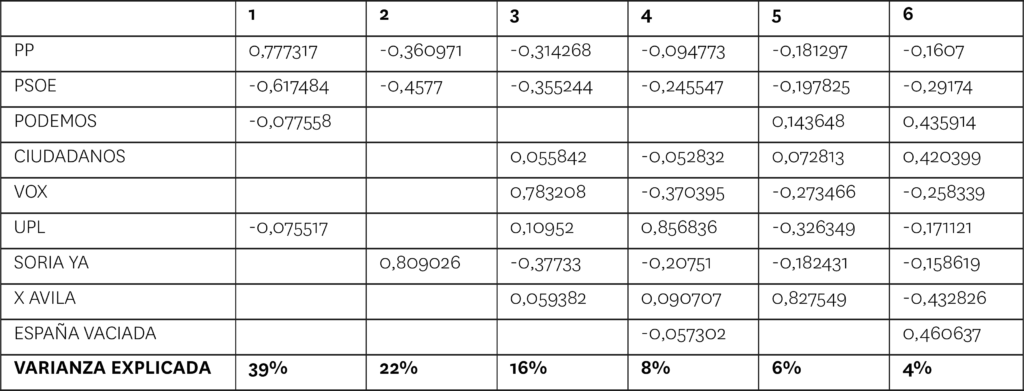
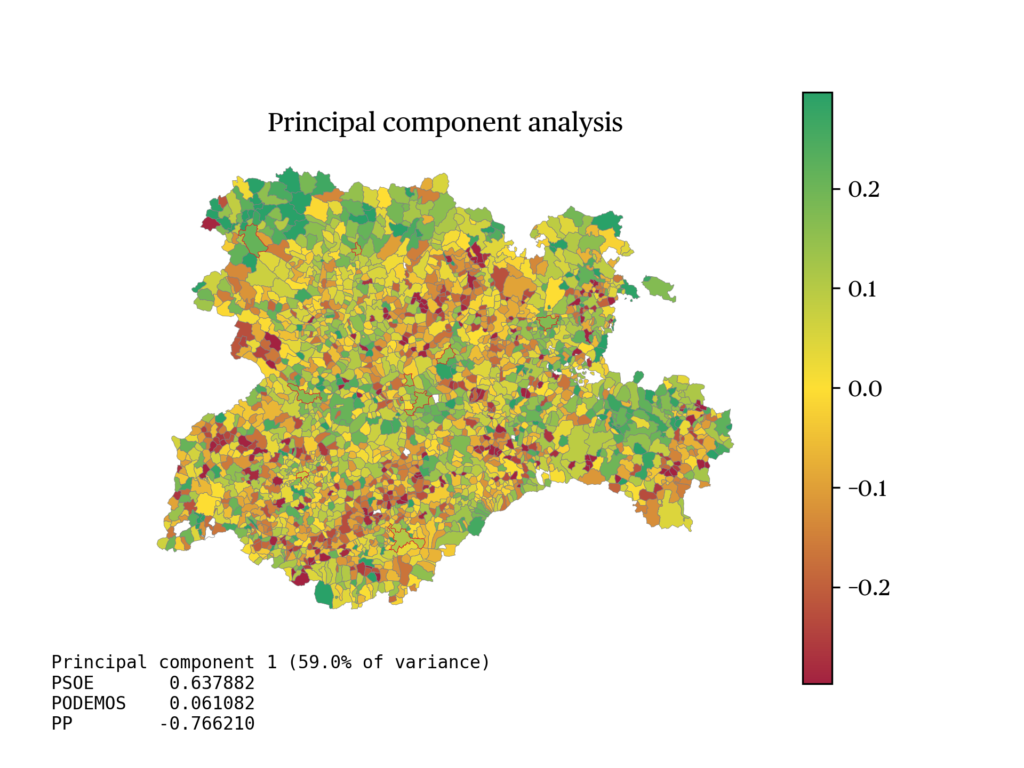
first component, 2019 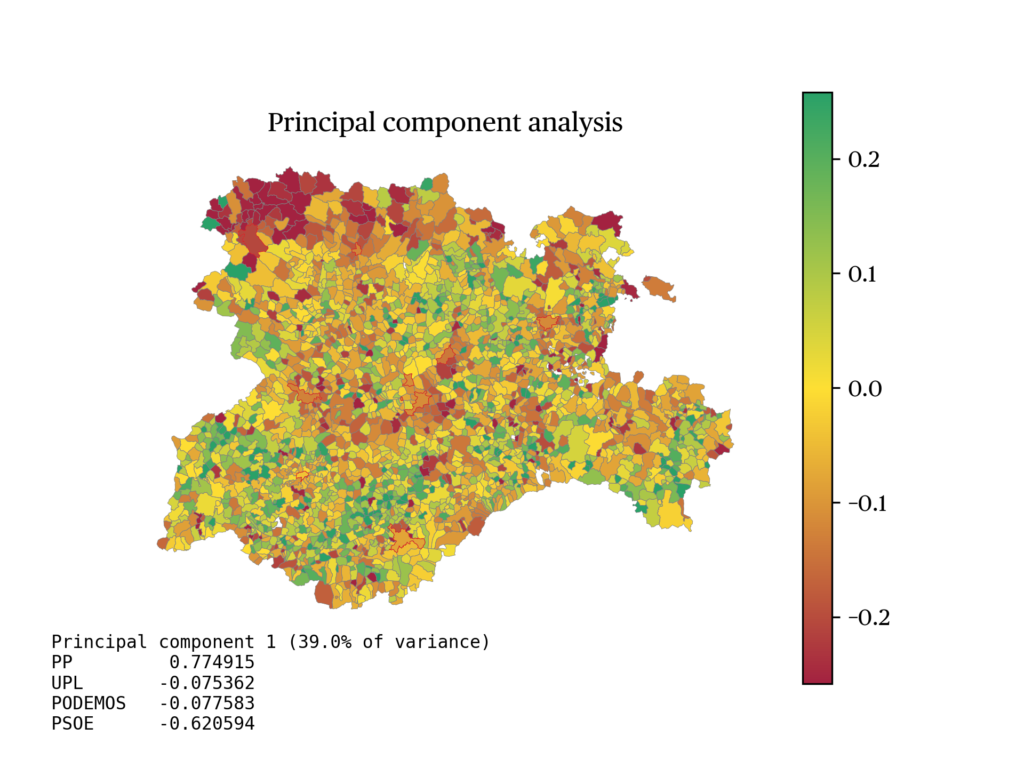
first component, 2021 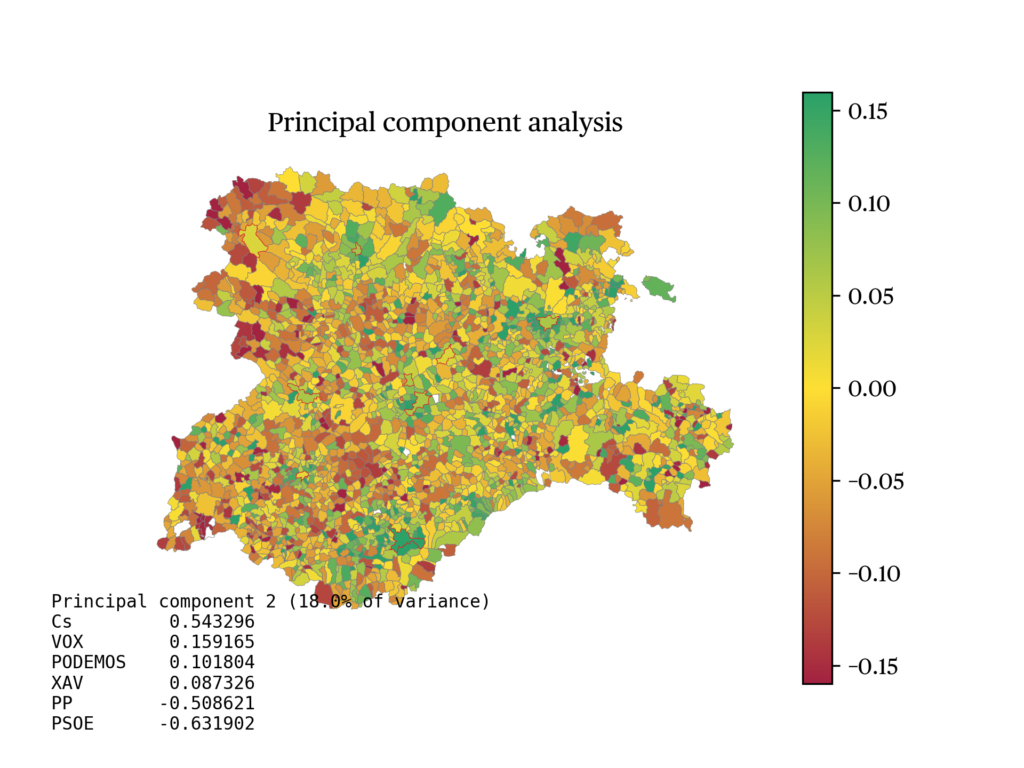
second component, 2019 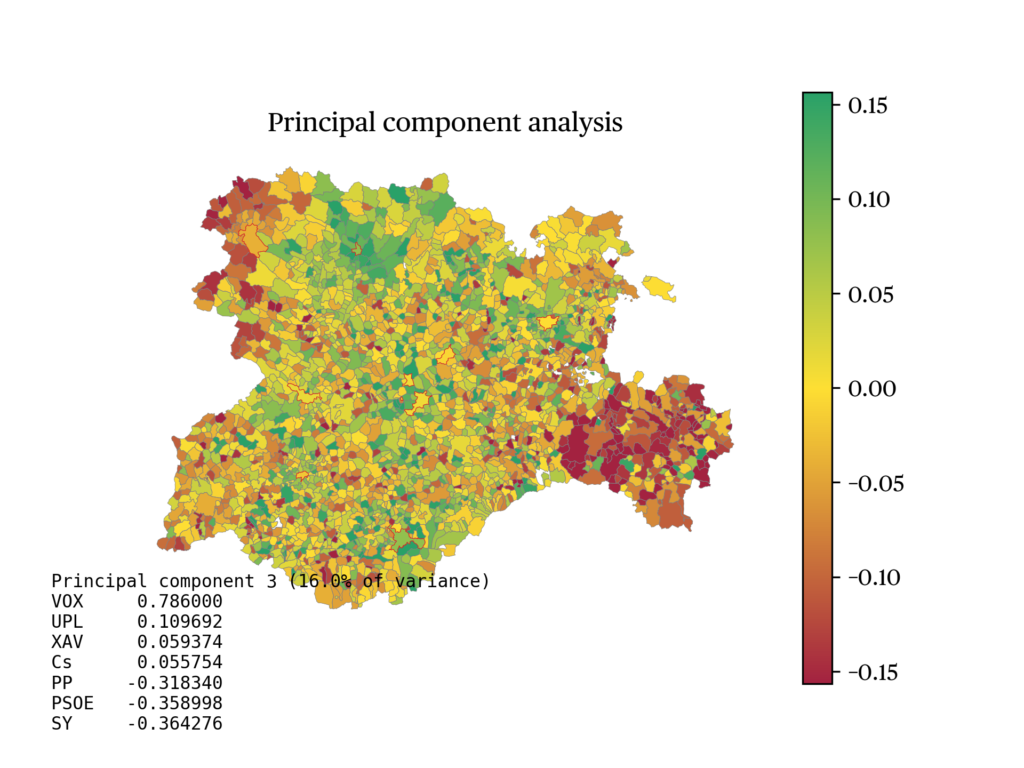
third component, 2021
Final note: National tactical errors that explain regional results
The results of this election were to a large extent the consequence of two tactical errors committed by the governing parties since 2019. Both were due to an inaccurate evaluation of opinion polls results by the national party leadership, leading to regional politics being neglected in the face of national party interests.
Following its victory in Madrid in 2021, and based on the opinion polls of the time, the Partido Popular decided to end the government coalition with Ciudadanos. It followed a regional strategy subordinated to a future victory in the national elections of the then national chairman of the PP (Pablo Casado, which later resigned, in part because of the failure of his party in this very election).
Ciudadanos was originally a liberal party that would participate in both PSOE- (Andalusia 2015) and PP-led governments. After the 2019 national elections, it could have formed a coalition government with the PSOE. However, some polls at the time claimed that it could then overtake the Popular Party and become the main center-right party. For this reason, it decided to reject such a coalition and instead push for new general elections. This stategy was transferred to the regional level, where Ciudadanos exclusively collaborated with right-wing parties. In Castilla y León, the result of the 2019 election would have allowed a coalition of the PSOE (which had won the election) with Ciudadanos. The national leadership of Ciudadanos, however, instead decided to implemented its national strategy of rejecting alliances with the left in order for the party to conquer the right. In the following election, in 2022, it has lost three quarters of its electorate and is left with a single seat in parliament.
Conclusion
Castilla y León has a long record as a right-leaning Autonomous Community, in which the Popular Party has been governing for 35 uninterrupted years.
Since 2015, in line with national trends, new parties (Podemos, Ciudadanos, and Vox) have obtained seats in parliament. The traditional parties (PP and PSOE) have concentrated most of the votes (over 60%) and seats (over 70%). However, new national parties have gathered around 25% of the votes and 18% of the seats since that date, despite the leading “new” party changing from one election to the other as it did in the rest of Spain.
The main novelty of the 2022 election is the increase in provincial vote, which has led to an important increase of the corresponding vote shares. From 5% of the votes and 2.5% of the seats in 2019, the score of provincial parties has increased to 9% of votes and seats in 2022. The discourse revolving around the institutional abandonment of some of the provinces, which have suffered strong population losses in areas already characterized by low population density, has now been translated into political representation (as with other phenomena, this first occurred in other parts of Spain, and then in Castilla y León). It remains to be seen if this trend will be confirmed in subsequent elections, as it happened for the new national parties. Unless the other two new parties, Vox has been able to benefit from this discourse, and has obtained good results in the less urban areas of the Community.
Notes
citer l'article
Luis Mena Martínez, Regional election in Castilla y León, 13 February 2022, Oct 2022,
à lire dans cette issue
voir toute la revue






